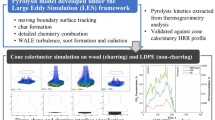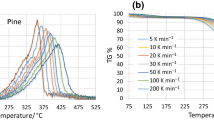Abstract
During fire, charring and non-charring polymers undergo reactions in the solid phase (pyrolysis) and in the gas phase (combustion). These reactions can be modelled using computational fluid dynamics-based fire modelling for the prediction of fire growth and spread. Given that many fire properties vary with temperature including heating rate and radiation flux, improvements in fire simulations can be made by accounting for these variations. This study characterizes the fire properties of the non-charring synthetic polymer poly(methyl methacrylate) (PMMA) for coupled pyrolysis and combustion simulation. Under pyrolysis, the heat of reaction of PMMA varies with heating rate due the change in residence time facilitating volatilization at any given temperature, particularly at higher heating rates. As a result, the volatiles are formed when the sample has reached higher temperature and therefore more heat flow is needed to assist this process at higher heating rates. Similarly, combustion parameters are also found to vary with the incident radiation flux; however, the variation is relatively minimal. In this study, thermal conductivity and specific heat capacity did not vary with temperature for PMMA.








Similar content being viewed by others
Abbreviations
- A :
-
Pre-exponential factor, s−1
- A′:
-
Area under the peak, m2
- A T :
-
Area under the curve, m2
- C p :
-
Specific heat capacity, J kg−1 °C−1
- E a :
-
Activation energy, kJ min−1
- EHoC:
-
Effective heat of combustion, kJ kg−1
- HoR:
-
Heat of reaction, kJ kg−1
- HRR:
-
Heat release rate, kW
- \(k\) :
-
Conductivity, W m−1 °C−1
- MLR:
-
Mass loss rate, m2 kg−1
- MC:
-
Moisture content, %
- m i :
-
Sample mass at the approximation
- \(\dot{m^{\prime\prime}}\) :
-
Mass loss rate per unit area, kg m−2 s−1
- n :
-
Reaction order
- \(\dot{q}_{\text{c}}^{{\prime \prime }}\) :
-
Convective heat flux, kW m−2
- \(\dot{q}_{\text{r}}^{{\prime \prime }}\) :
-
Radiative heat flux, kW m−2
- R :
-
Universal gas constant, J kg−1 mol−1 K−1
- SEA:
-
Specific extinction area, m2 kg−1
- s :
-
Solid
- T :
-
Temperature, °C or K
- T 1 :
-
Peak 1 integration temperature, °C
- T 2 :
-
Peak 2 integration temperature, °C
- t :
-
Time, s
- x i :
-
Mass loss fraction
- Y :
-
Weight fraction of conversion
- y i :
-
Fraction of ith gaseous products yield
- dY/dT :
-
Pyrolysis rate
- dt/dT :
-
Heating rate
- w :
-
Instantenous sample mass, mg
- w i :
-
Initial sample mass, mg
- w f :
-
Final sample mass, mg
- w fc :
-
Final sample mass (cone), mg
- w ic :
-
Initial sample mass (cone), mg
- β :
-
dT/dt or heating rate, K s−1
- ΔE :
-
Heat flow into DSC sample, mW
- ΔH DSC :
-
Normalized enthalpy, kJ kg−1
- ΔH :
-
Heat of reaction, kJ kg−1
- ΔH R :
-
Heat of reaction in fire model, kJ kg−1
- ΔH con :
-
Normalized HoR, kJ kg−1
- ΔH enh :
-
Enhanced HoR, kJ kg−1
- ρ :
-
Density, kg m−3
- ν s :
-
Yield of solid residue, %
References
McGrattan K, et al. Fire dynamics simulator (version 6.2): user’s guide. Gaithersburg: National Institute of Standard and Technology; 2015.
Abu-Bakar AS, Moinuddin KAM. Effects of variation in heating rate, sample mass and nitrogen flow on chemical kinetics for pyrolysis. In: 18th Australasian fluid mechanics conference. Launceston, TAS; 2012.
Font R, et al. Kinetics of pyrolysis and combustion of pine needles and cones. J Anal Appl Pyrol. 2009;85(1):276–86.
Gai C, Dong Y, Zhang T. The kinetic analysis of the pyrolysis of agricultural residue under non-isothermal conditions. Bioresour Technol. 2013;127:298–305.
Jiang Y. Decomposition, ignition and flame spread on furnishing materials. Melbourne: CESARE, Victoria University; 2006.
Matala A, Hostikka S, Mangs J. Estimation of pyrolysis model parameters for solid materials using thermogravimetric data. Fire Saf Sci. 2008;9:1213–23.
Starink MJ, Gregson PJ. A quantitative interpretation of DSC experiments on quenched and aged SiCp reinforced 8090 alloys. Scr Metall Mater. 1995;33(6):893–900.
American Society for Testing and Materials. ASTM 1354-04a, standard test method for heat and visible smoke release rates for materials and products using an oxygen consumption calorimeter. West Conshohocken, PA: ASTM International; 2004. www.astm.org. Accessed 03 Feb 2010.
Shi L, Chew MYL. A review of fire processes modeling of combustible materials under external heat flux. Fuel. 2013;106:30–50.
Xu Q, et al. Discuss the heat release capacity of polymer derived from microscale combustion calorimeter. J Therm Anal Calorim. 2018;133(1):649–57.
Xu Q, et al. A PMMA flammability analysis using the MCC. J Therm Anal Calorim. 2016;126(3):1831–40.
Pau DSW. A comparative study on combustion behaviours of polyurethane foams with numerical simulations using pyrolysis models. Christchurch: Civil and Natural Resources Engineering, University of Canterbury; 2013.
Viswanath SG, Gupta MC. Estimation of nonisothermal kinetic parameters from a TG curve by the methods of overdetermined system and inflection point. Thermochim Acta. 1996;285(2):259–67.
Wadhwani R, et al. Kinetics of pyrolysis of litter materials from pine and eucalyptus forests. J Therm Anal Calorim. 2017;130(3):2035–46.
McGrattan K, Forney G. Fire dynamics simulator (version 4) user’s guide. 4th ed. Washington: US Government Printing Office; 2006.
Gustafsson SE. Transient plane source techniques for thermal conductivity and thermal diffusivity measurements of solid materials. Rev Sci Instrum. 1991;62(3):797–804.
Sibulkin M. Heat of gasification for pyrolysis of charring materials. In: Proceedings of the first international symposium on fire safety science. Boca Raton: CRC Press; 1986.
Kodur VKR, Harmathy TZ. Properties of building materials. In: DiNenno PJ, editor. SFPE handbook of fire protection engineering. 3rd ed. Berlin: Springer; 2002. p. 155–81.
Huffman R, Pan W-P. Combining DSC and TG data for measuring heats of reaction. Thermochim Acta. 1990;166:251–65.
Rath J, et al. Heat of wood pyrolysis. Fuel. 2003;82(1):81–91.
Abu-Bakar AS. Characterization of fire properties for coupled pyrolysis and combustion simulation and their optimised use. Melbourne: College of Engineering and Science, Victoria University; 2015.
Fang MX, et al. Kinetic study on pyrolysis and combustion of wood under different oxygen concentrations by using TG-FTIR analysis. J Anal Appl Pyrol. 2006;77(1):22–7.
Gao N, et al. TG–FTIR and Py–GC/MS analysis on pyrolysis and combustion of pine sawdust. J Anal Appl Pyrol. 2013;100:26–32.
Luche J, et al. Characterization of thermal properties and analysis of combustion behavior of PMMA in a cone calorimeter. Fire Saf J. 2011;46(7):451–61.
American Society for Testing and Materials. ASTM E2160-04 standard test method for heat of reaction of thermally reactive materials by differential scanning calorimetry. West Conshohocken, PA: ASTM International; 2004. www.astm.org. Accessed 03 Feb 2010.
Hostikka S. 2012. (Personal Communication)
Matala A. Estimation of solid phase reaction parameters for fire simulation. Espoo: Faculty of Information and Natural Sciences, Helsinki University of Technology; 2008.
Li K-Y, et al. Pyrolysis of medium-density fiberboard: optimized search for kinetics scheme and parameters via a genetic algorithm driven by Kissinger’s method. Energy Fuels. 2014;28(9):6130–9.
Zhang Z et al. Effect of temperature and heating rate in pyrolysis on the yield, structure and oxidation reactivity of pine sawdust biochar. In: Chemeca 2013: challenging tomorrow. Barton, ACT: Engineers Australia; 2013. p. 863–9.
Kim S-S, et al. Pyrolysis kinetics and decomposition characteristics of pine trees. Bioresour Technol. 2010;101(24):9797–802.
Wang G, et al. TG study on pyrolysis of biomass and its three components under syngas. Fuel. 2008;87(4):552–8.
Mui ELK, et al. Kinetic study on bamboo pyrolysis. Ind Eng Chem Res. 2008;47(15):5710–22.
Kashiwagi T, Inaba A, Brown JE. Differences in PMMA degradation characteristics and their effects on its fire properties. Fire Saf Sci. 1986;1:483–93.
Kissinger HE. Variation of peak temperature with heating rate in differential thermal analysis. J Res Nat Bur Stand. 1956;57(4):217–21.
Missoum A, Gupta AK, Chen J. Global kinetics of the thermal decomposition of waste materials. In: Thirty-second intersociety energy conversion engineering conference (IECEC-97). Honolulu, HI; 1997. p. 636–41.
Quan C, Li A, Gao N. Thermogravimetric analysis and kinetic study on large particles of printed circuit board wastes. Waste Manag. 2009;29(8):2353–60.
Milosavljevic I, Oja V, Suuberg EM. Thermal effects in cellulose pyrolysis: relationship to char formation processes. Ind Eng Chem Res. 1996;35(3):653–62.
Lautenberger C, Rein G, Fernandez-Pello C. The application of a genetic algorithm to estimate material properties for fire modeling from bench-scale fire test data. Fire Saf J. 2006;41(3):204–14.
Opfermann J. Kinetic analysis using multivariate non-linear regression. I. Basic concepts. J Therm Anal Calorim. 2000;60(2):641–58.
Ballistreri A, Montaudo G, Puglisi C. Reliability of the volatilization method for determination of the activation energy in the thermal decomposition of polymers. J Therm Anal. 1984;29(2):237–41.
Zhang H. Fire-safe polymers and polymer composites. Washington: Federal Aviation Administration, Office of Aviation Research; 2003.
Han TU, et al. Pyrolysis kinetic analysis of poly(methyl methacrylate) using evolved gas analysis-mass spectrometry. Korean J Chem Eng. 2017;34(4):1214–21.
Ang HG, Pisharath S. Energetic polymers. New York: Wiley; 2012.
Haseli Y, van Oijen JA, de Goey LPH. Modeling biomass particle pyrolysis with temperature-dependent heat of reactions. J Anal Appl Pyrol. 2011;90(2):140–54.
Peterson JD, Vyazovkin S, Wight CA. Kinetic study of stabilizing effect of oxygen on thermal degradation of poly(methyl methacrylate). J Phys Chem B. 1999;103(38):8087–92.
Frederick WJ, Mentzer CC. Determination of heats of volatilization for polymers by differential scanning calorimetry. J Appl Polym Sci. 1975;19(7):1799–804.
Harper CA. Handbook of building materials for fire protection. New York: McGraw-Hill; 2004.
Steinhaus T. Evaluation of the thermophysical properties of poly(methylmethacrylate): a reference material for the development of a flammability test for micro-gravity environments. College Park: Department of Fire Protection Engineering, The University of Maryland; 1999.
Zeng WR, Li SF, Chow WK. Preliminary studies on burning behavior of polymethylmethacrylate (PMMA). J Fire Sci. 2002;20(4):297–317.
Spearpoint MJ, Quintiere JG. Predicting the piloted ignition of wood in the cone calorimeter using an integral model: effect of species, grain orientation and heat flux. Fire Saf J. 2001;36(4):391–415.
Linteris GT et al. Modeling solid sample burning. In: Eighth international symposium international association for fire safety science (IAFSS). Boston, MA; 2005.
Nelson GL, Jayakody C. Flame retardant polyurethane. In: Flame retardant polymerics: electrical/electronic applications. Boca Raton: CRC Press; 1998. p. 1–28.
Babrauskas V, Peacock RD. Heat release rate: the single most important variable in fire hazard. Fire Saf J. 1992;18(3):255–72.
Mulholland GW, Croarkin C. Specific extinction coefficient of flame generated smoke. Fire Mater. 2000;24(5):227–30.
Assael MJ, et al. Thermal conductivity of polymethyl methacrylate (PMMA) and borosilicate crown glass BK7. Int J Thermophys. 2005;26(5):1595–605.
Jansson R. Measurement of thermal properties at elevated temperatures: Brandforsk project 328-031. SP report 2004:46, 2004.
Smith WF, Hashemi J. Polymeric materials. In: Foundations of materials science and engineering. New York: McGraw-Hill; 2006. p. 515–6.
Acknowledgements
The authors wish to acknowledge the technical and financial assistance provided by Omnii Pty Ltd, Xtralis and Scientific Fire Services. The authors also acknowledge stimulating discussions with Dr. Yun Jiang of Xtralis. Ariza S. Abu-Bakar was a Ph.D. candidate at Victoria University funded by Universiti Sains Malaysia and currently employed by the same university.
Author information
Authors and Affiliations
Corresponding author
Rights and permissions
About this article
Cite this article
Abu-Bakar, A.S., Cran, M.J. & Moinuddin, K.A.M. Experimental investigation of effects of variation in heating rate, temperature and heat flux on fire properties of a non-charring polymer. J Therm Anal Calorim 137, 447–459 (2019). https://doi.org/10.1007/s10973-018-7941-0
Received:
Accepted:
Published:
Issue Date:
DOI: https://doi.org/10.1007/s10973-018-7941-0




